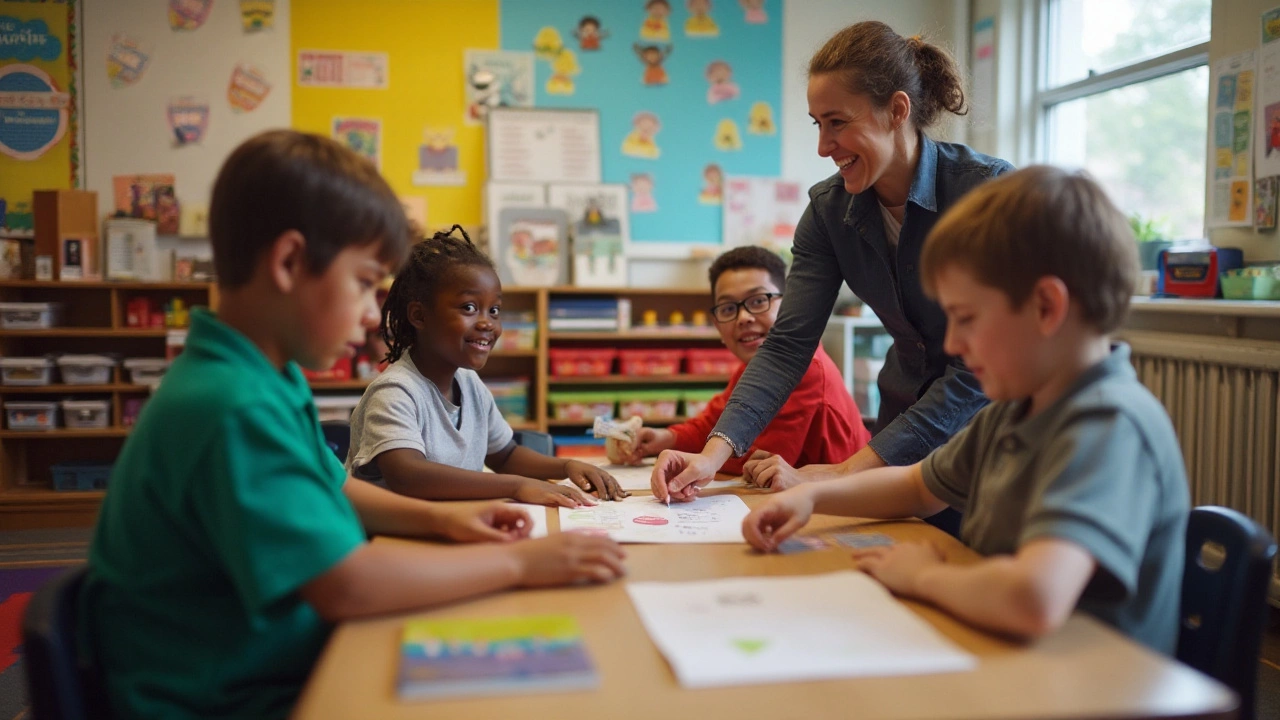Words hold incredible power, especially in education settings where they can either build bridges of understanding or walls of exclusion. This is particularly true when it comes to referring to children who require additional support in their learning journeys.
For years, the phrase 'children with special needs' has been used, often with the best intentions. However, as society becomes more aware of the nuances in language and its impact, a debate has emerged about the appropriateness of this terminology. Is it still valid and respectful, or should it be reconsidered to better reflect the values of inclusivity and respect?
This article aims to explore these questions, looking at how language in the realm of special education has evolved and why it is so important to get it right. Whether you're an educator, a parent, or simply someone eager to learn, dive into the nuances of how we talk about children with unique challenges and what it means for their place in the world.
- The Evolution of Language in Special Needs Education
- Why Words Matter
- Contemporary Perspectives on Terminology
- Impact of Language on Society and Attitudes
- Inclusive Communication Strategies
- Tips for Educators and Parents
The Evolution of Language in Special Needs Education
Sculpted by decades of social transformation, the language we use to describe children with special needs has an intricate history. In the early 20th century, terms that would now be considered derogatory were commonly accepted, reflecting broader societal attitudes towards disabilities. These descriptors were often created without input from those they labeled, which drove a marginalizing narrative, confining individuals to outdated stereotypes.
As we progressed towards the mid-20th century, the civil rights movement had an echoing effect on disability rights, influencing a shift in language. Phrases like 'handicapped' were introduced as more sensitive alternatives, aiming to replace harsh words with those that recognized human dignity. During this time, advocacy groups started emphasizing the person's identity over the disability, spawning the term 'children with disabilities', which stressed seeing the child first.
The late 20th century brought about another evolution where 'special needs' gained popularity. This term was crafted to address the unique support these children required in educational settings. As a more inclusive language took hold, educators and policymakers began focusing less on the limitations and more on individualized support to help each child thrive. A noteworthy example of this period is the introduction of the Individuals with Disabilities Education Act (IDEA) in the United States. This pivotal piece of legislation mandated specific educational plans tailored for each child, indicating a government-level shift in perception and action towards educating children traditionally sidelined.
Interestingly, this evolution was not widely linear or universally accepted. Different countries and cultures adapted at varying paces, and the term 'special needs' remained controversial in certain circles. Critics mention that while 'special needs' reduces the stigma aligned with medical diagnoses, it may inadvertently isolate individuals by suggesting their needs are indeed special, or outside normal expectations. It has sparked debates on whether needs related to disability should inherently be regarded as 'special' or rather as equally valid as any other educational requirement. A thought-provoking perspective comes from Judith Snow, a prominent advocate for inclusion, who stated in her speech,
"The journey towards respectful, inclusive language is as vital as creating physical spaces for inclusion."
As a growing understanding of neurodiversity and different learning needs surfaces, today’s educators are encouraged to continue evolving the language they use. This progression is more than just semantics—it plays a crucial role in shaping how society views and treats these children. Educators today are equipped with more awareness and compassion, but the dialogue remains dynamic, always adapting to the changing landscapes of inclusivity and special education. This ongoing evolution in language is instrumental in how society continues to address not just education, but also acceptance and integration of children of all abilities.
Why Words Matter
Words have a profound impact on how we perceive ourselves and others, influencing our mindset and behaviors consciously and subconsciously. In the context of special needs education, choosing the right words can make all the difference in fostering an atmosphere of inclusivity and acceptance. The term 'children with special needs' has been widely accepted for decades, serving as a descriptor for those who require additional support to access education on par with their peers. However, it's essential to understand that language is dynamic and evolves alongside society's growing awareness and understanding.
The significance of words extends beyond mere labels; they shape the identity of individuals. Referring to someone as a 'child with special needs' rather than a 'special needs child' emphasizes their humanity before their challenges. This slight alteration in phrasing can signal respect and understanding, helping to dismantle stereotypes. Studies in social psychology have shown that depersonalizing language can influence attitudes negatively, leading to perceived limitations rather than potentials. It's crucial for educators, parents, and peers alike to recognize these subtleties.
Additionally, language reflects cultural values and can contribute to stigmatization if not chosen carefully. Terms that once seemed neutral might become outdated or offensive as societies progress. An astute awareness of how words can morph into tools of empowerment over time is paramount. The linguistic shift mirrors the expanded understanding of human diversity and the commitment to ensuring that every child's unique abilities are recognized and celebrated. Moreover, striving to use language that affirms dignity is an educational imperative.
Imagine a classroom where labels lead learning. Research, including that conducted by the Inclusive Education Canada, underscores the importance of terminology that acknowledges students' multifaceted lives rather than reducing them to their educational needs. In this sense, words catalyze not only perception but also policy change. Policies founded on inclusive language pave the way for comprehensive teaching practices that can accommodate a broader spectrum of learning profiles.
"The way we talk to our children becomes their inner voice," posits Peggy O'Mara, editor and publisher, reminding us of the intimate connection between language and self-image.
Shaping inclusive environments also involves educating stakeholders on sensitive language use. Training for teachers and administrators often includes modules on diversity and equity, highlighting the importance of adaptable communication. Engagement in conversations around language positions educators and parents alike to better advocate for students within the realm of inclusive education. Open discussions guide communities in aligning their values with words that genuinely embody those ideals.
Language plays a key role in societal development. It is a reflection of our morals and ideologies. As terms in educational settings, like 'children with special needs', transform, they do so to accommodate the growing understanding of each child's unique potential. By prioritizing expressions that uplift and respect individual capacities, we enable students to see themselves as capable contributors to the world. Thus, we pave pathways to a society that honors diversity, equity, and belonging for all.

Contemporary Perspectives on Terminology
In today's world, the way we address and describe various aspects of life is constantly evolving, and this holds true in the context of education, especially when discussing children with special needs. As we strive to create more inclusive settings and embrace diversity, the language we use becomes even more significant. The phrase 'children with special needs' has been under scrutiny, as more educators and advocates call for terminology that better reflects the dignity and individuality of each child. One argument centers around the idea of labeling, a phenomenon that can unintentionally impose limits on children by defining them through their needs rather than their unique capabilities. Consequently, contemporary discussions advocate for a more person-first approach in language usage.
Critics of traditional terminology often point out that labels like 'special needs' can inadvertently promote stereotypes or feelings of pity. This is why a shift is occurring, with many preferring terms such as 'children with unique learning preferences' or 'children receiving additional support.' These alternatives focus on the strengths and distinct learning styles of children, fostering an environment of empowerment rather than limitation. Professional organizations and advocacy groups increasingly recommend language that puts the child before the descriptor, a subtle yet meaningful change that promotes the understanding that every child is a learner first. According to a 2023 survey by the Inclusive Education Foundation, 68% of teachers favor person-first language as they believe it minimizes bias and supports an inclusive atmosphere.
"Language shapes the way we think, and determines what we can think about," said Benjamin Lee Whorf, a linguistic scholar who emphasized the profound impact words have on our cognition and social interactions.Insights like these highlight the evolving attitudes toward language in educational settings. As we move deeper into the digital age, where communication is instantaneous and expansive, the ripple effect of words is more significant than ever. By fostering discussions around the appropriate terminology, educators and society at large are embracing an opportunity to reframe narratives and cultivate a richer understanding of diversity.
It is also important to note that shifts in terminology are not universally accepted, and perspectives can vary significantly depending on cultural, regional, or individual beliefs. Some communities might not view the term 'special needs' in a negative light but as a simple descriptor of the additional services and support a child receives. Thus, cultural sensitivity and dialogue remain key. Community input and engagement in crafting these language preferences are paramount to ensuring they reflect the collective values and understanding of those they represent. By recognizing the diverse perspectives on this sensitive issue, we can continue to progress towards an educational environment that truly respects and uplifts every child's journey.
Impact of Language on Society and Attitudes
Language shapes our perceptions and attitudes in profound and subtle ways. Words are not merely tools for communication; they are the lenses through which people view the world. In the context of education, and particularly special needs education, the language used can significantly influence how children with special needs are perceived by both their peers and educators. When we label students, intentionally or unintentionally, it affects their self-image and determines their place in the educational ecosystem. For years, using terms like 'special needs' was seen as progressive, an effort to direct attention to the unique support these children deserve. However, this terminology can inadvertently contribute to a sense of 'otherness,' creating barriers to true inclusivity.
The language we choose can reinforce societal stereotypes or challenge them. For instance, referring to students as 'differently-abled' rather than 'disabled' shifts the focus from a deficit-oriented perspective to one highlighting ability and potential. This is crucial in fostering an environment where teachers and peers see the capabilities rather than the limitations. Numerous studies have shown the language around special needs can either open doors to opportunities or shut them with stigma. A 2019 survey by the National Center for Special Education Research found educators who used more ability-focused language had students with higher engagement levels and improved academic performance.
One must question the dominant narratives that language helps perpetuate. Are these children seen primarily for their challenges, or for their potential? Language, consciously selected, can challenge entrenched biases and cultivate new understandings. As society evolves, so too does the language it uses. Engaging with contemporary language reforms isn't about being politically correct, but about respecting and fostering dignity and potential. A shift from 'students with special needs' to 'students requiring additional support' could help reframe the educational narrative to be more inclusive.
"The language we use is powerful. It is a mirror of our own perceptions and attitudes. By choosing words that respect dignity, we can help shape a more inclusive world." — Temple Grandin
It's important to remember the broader impact language has beyond the classroom. Children grow up in a society that shapes their identity, largely influenced by how they are talked about. A positive public discourse can inspire confidence and self-esteem, while negative language may hinder self-worth and potential growth. As educators, parents, and members of society, embracing language that empowers instead of limits is crucial.

Inclusive Communication Strategies
Creating an environment where every child feels welcomed and understood is at the heart of special needs education. To achieve this, educators and parents alike must engage in inclusive communication strategies that respect each child's unique experiences and needs. This begins with the language we choose to use. Shifting to person-first language, which emphasizes the individual before their condition, is one effective approach. For instance, instead of saying 'autistic child', say 'child with autism'. This small but significant change in wording helps to underscore the humanity of the individual and can foster greater empathy and understanding among peers and educators alike.
Additionally, it is important to consider the child's perspective and involve them in conversations about their educational needs and preferences. Encouraging them to express their feelings and thoughts can build their confidence and autonomy. Parents and teachers can create open dialogue by asking open-ended questions and actively listening to the child's responses. This communication should be ongoing and evolving, just as the child grows and changes.
Understanding and integrating non-verbal communication methods can also be crucial in reaching children who may struggle with verbal interactions. Tools such as picture exchange communication systems (PECS) or sign language can empower children with unique challenges to express themselves more freely. Educators should receive training on these alternative communication methods to support children who might benefit from them. By diversifying communication strategies, educators can ensure that every child has a way to engage and participate meaningally in their learning environment.
Implementing inclusive communication strategies also requires the collaboration of the entire educational community. Schools should foster an inclusive culture that embraces diversity and encourages mutual respect and understanding among students and staff. Workshops, training sessions, and awareness programs can be valuable in educating all school members about the importance of inclusive language and practices. Additionally, it is beneficial to create opportunities for parents to engage with one another and share their experiences and strategies for fostering inclusive communication at home. This can strengthen the support network for both children and parents.
Incorporating technology into communication strategies can further enhance inclusivity. Digital tools and apps designed for children with special needs can offer personalized learning experiences and facilitate communication. For example, speech-to-text applications and interactive learning platforms can make accessing education more equitable for children with different capabilities. Educators can collaborate with technologists to explore innovative solutions that fit their students' needs. However, it is crucial to ensure that all technological additions are accessible and do not create new barriers for families with limited resources.
Ultimately, inclusive communication is about creating a space where every voice is heard, respected, and valued. As Helen Keller once said, "Alone we can do so little, together we can do so much." Recognizing and valuing each individual's unique perspective enables us to harness the collective strength of the community and provides better educational outcomes for children with special needs.
Tips for Educators and Parents
Engaging with children who have special needs requires a nuanced understanding and a compassionate approach. The role of educators and parents in nurturing an inclusive environment is crucial. One of the primary things to keep in mind is the value of patience and persistence. Patience paves the way for trust, allowing children to feel secure and understood, which is essential for their growth and learning. Educators should strive to learn each child's individual needs. Every child's needs are unique, and what works for one may not necessarily suit another. So, taking the time to understand these specific requirements can make all the difference. In the classroom, adapting teaching methods to accommodate various learning styles is crucial for fostering an inclusive atmosphere.
Consistent communication between educators and parents cannot be underestimated. Regular updates allow for a holistic view of the child's progress and challenges, making it easier to tailor strategies that work both in the classroom and at home. Active listening during these conversations ensures that both parties are on the same page and can collaboratively devise approaches for supporting the child's needs. It's advantageous for this two-way communication to stay open and honest, fostering a partnership aimed at the child's best interest. Moreover, involving children in this dialogue, when appropriate, can empower them, providing them with a sense of agency and understanding of their learning journey. One educational philosophy, known as Universal Design for Learning (UDL), advocates for flexibility in the way students access materials, engage with content, and show their understanding, ensuring that barriers to learning are minimized right from the start.
Providing appropriate resources is another intersecting area between home and school. Books, games, and other materials that embrace diverse abilities can be invaluable in creating an inclusive environment. These can help in normalizing differences and introducing concepts of diversity to all children. Educators are encouraged to source materials that encapsulate a spectrum of experiences and abilities, promoting a culture of empathy and acceptance. For parents, encouraging this attitude at home through inclusive stories and conversations is as vital. It's beneficial to involve children in activities that allow them to interact with peers of different abilities. This not only builds social skills but also cultivates mutual respect and understanding. Remember, it's less about elimination of risks and more about teaching manageable and calculated approach to taking risks.
Training and education are pivotal for both educators and parents to stay informed about the best practices and novel strategies in inclusive education. Workshops, online courses, and seminars can provide insights into the latest research and findings. This continuous learning ensures that the adults in a child's life are equipped with the most effective tools available. Social media platforms and online communities also offer a vast array of support networks and resources. Joining these can provide a sense of community and shared wisdom that can be incredibly supportive. Don't hesitate to learn from those who have first-hand experience, as their insights can be valuable.
Today's technology offers powerful tools tailored to support different learning needs. Utilizing apps and software designed for special needs can enhance learning experiences significantly. From text-to-speech applications to customizable learning platforms, incorporating technology can provide personalized learning solutions. A report by Common Sense Education highlights how educational technology can bridge gaps, providing access to educational material in formats that suit the child's individual preferences. Parents, too, can make use of such technology at home to reinforce school learning, ensuring consistency and familiarity.
Lastly, nurture an environment of positive reinforcement and celebration of achievements, no matter how small. Recognizing a child's efforts and progress can bolster their confidence and motivation, encouraging them to push forward. Positive reinforcement helps in creating an atmosphere where children feel safe and eager to learn. Encouragement and acknowledgment of even the smallest triumphs build a supportive framework that values effort over outcome, teaching children the value of perseverance. By emphasizing this, educators and parents can create a robust support system that empowers children with special needs to thrive confidently in their educational pursuits.






